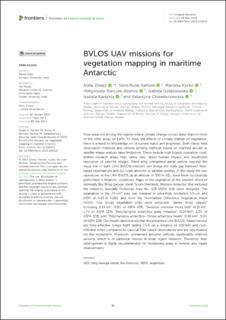| dc.contributor.author | Zmarz, Anna | |
| dc.contributor.author | Karlsen, Stein Rune | |
| dc.contributor.author | Kycko, Marlena | |
| dc.contributor.author | Korczak-Abshire, Małgorzata | |
| dc.contributor.author | Golebiowska, Izabela | |
| dc.contributor.author | Karsznia, Izabela | |
| dc.contributor.author | Chwedorzewska, K. | |
| dc.date.accessioned | 2023-08-17T10:22:25Z | |
| dc.date.available | 2023-08-17T10:22:25Z | |
| dc.date.created | 2023-05-09T11:14:01Z | |
| dc.date.issued | 2023 | |
| dc.identifier.citation | Frontiers in Environmental Science. 2023, 11 . | en_US |
| dc.identifier.issn | 2296-665X | |
| dc.identifier.uri | https://hdl.handle.net/11250/3084543 | |
| dc.description.abstract | Polar areas are among the regions where climate change occurs faster than on most of the other areas on Earth. To study the effects of climate change on vegetation, there is a need for knowledge on its current status and properties. Both classic field observation methods and remote sensing methods based on manned aircraft or satellite image analysis have limitations. These include high logistic operation costs, limited research areas, high safety risks, direct human impact, and insufficient resolution of satellite images. Fixed-wing unmanned aerial vehicle beyond the visual line of sight (UAV BVLOS) missions can bridge the scale gap between field-based observations and full-scale airborne or satellite surveys. In this study the two operations of the UAV BVLOS, at an altitude of 350 m ASL, have been successfully performed in Antarctic conditions. Maps of the vegetation of the western shore of Admiralty Bay (King George Island, South Shetlands, Western Antarctic) that included the Antarctic Specially Protected Area No. 128 (ASPA 128) were designed. The vegetation in the 7.5 km2 area was mapped in ultra-high resolution (<5 cm and DEM of 0.25 m GSD), and from the Normalized Difference Vegetation Index (NDVI), four broad vegetation units were extracted: “dense moss carpets” (covering 0.14 km2, 0.8% of ASPA 128), “Sanionia uncinata moss bed” (0.31 km2, 1.7% of ASPA 128), “Deschampsia antarctica grass meadow” (0.24 km2, 1.3% of ASPA 128), and “Deschampsia antarctica–Usnea antarctica heath” (1.66 km2, 9.4% of ASPA 128). Our results demonstrate that the presented UAV BVLOS–based surveys are time-effective (single flight lasting 2.5 h on a distance of 300 km) and cost-effective when compared to classical field-based observations and are less invasive for the ecosystem. Moreover, unmanned airborne vehicles significantly improve security, which is of particular interest in polar region research. Therefore, their development is highly recommended for monitoring areas in remote and fragile environments. | en_US |
| dc.language.iso | eng | en_US |
| dc.rights | Navngivelse 4.0 Internasjonal | * |
| dc.rights.uri | http://creativecommons.org/licenses/by/4.0/deed.no | * |
| dc.title | BVLOS UAV missions for vegetation mapping in maritime Antarctic | en_US |
| dc.title.alternative | BVLOS UAV missions for vegetation mapping in maritime Antarctic | en_US |
| dc.type | Peer reviewed | en_US |
| dc.type | Journal article | en_US |
| dc.rights.holder | © 2023 Zmarz, Karlsen, Kycko, KorczakAbshire, Gołębiowska, Karsznia and Chwedorzewska | en_US |
| dc.description.version | publishedVersion | en_US |
| cristin.ispublished | true | |
| cristin.fulltext | original | |
| cristin.qualitycode | 1 | |
| dc.identifier.doi | 10.3389/fenvs.2023.1154115 | |
| dc.identifier.cristin | 2146379 | |
| dc.source.journal | Frontiers in Environmental Science | en_US |
| dc.source.volume | 11 | en_US |
| dc.source.pagenumber | 11 | en_US |

